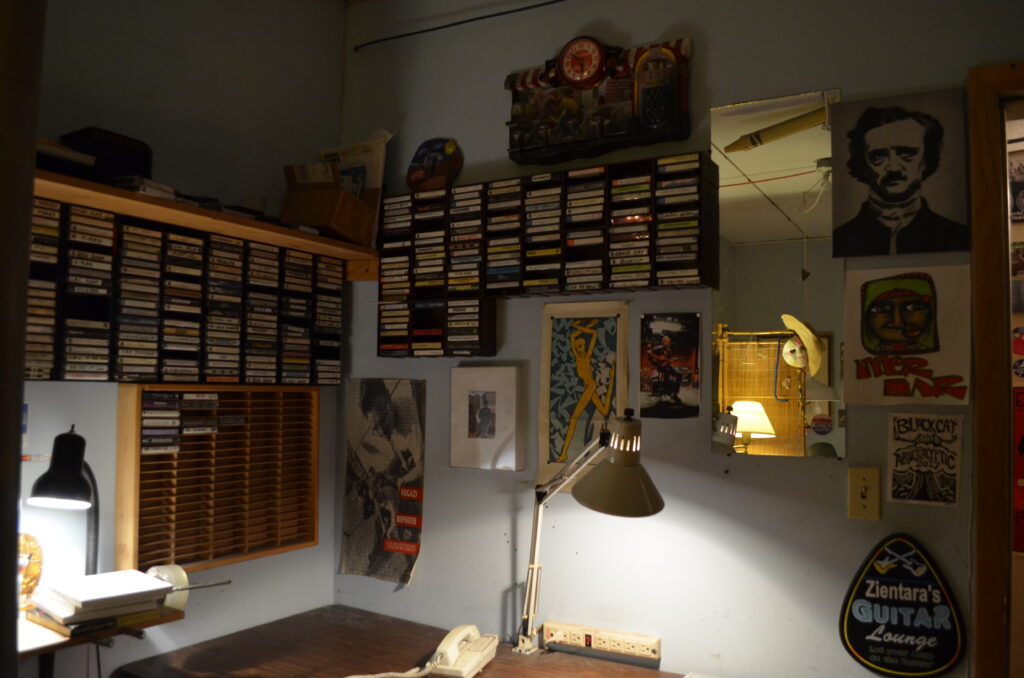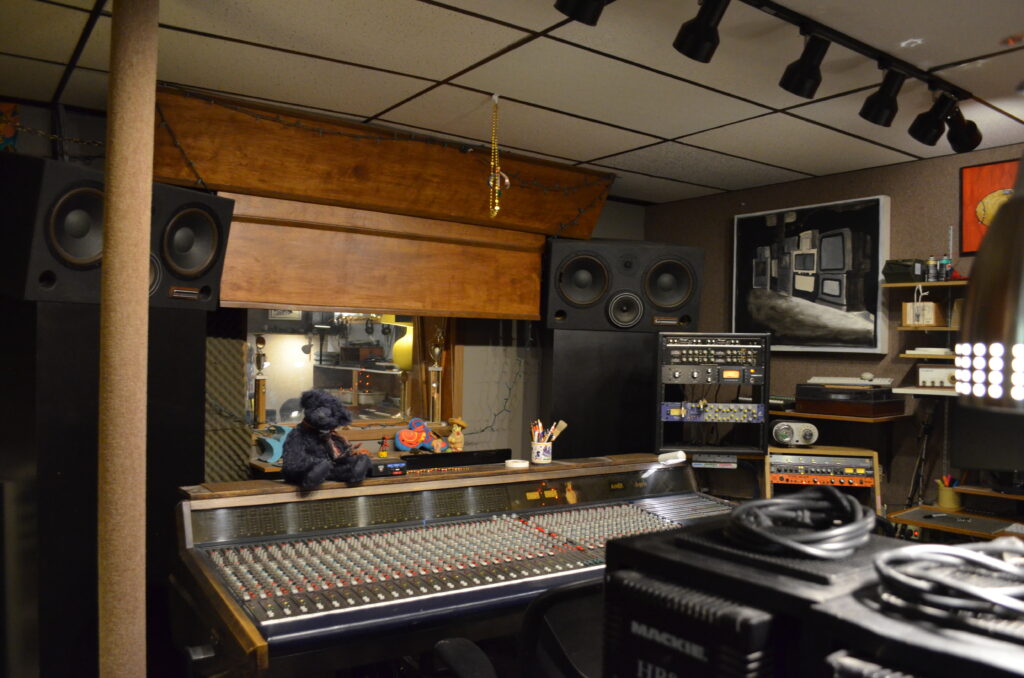
The low-key entrance to Inner Ear Studio at its former 2701 South Oakland Street location. From PG 250: Documenting Arlington’s Changing Scene.
When Don Zientara settled in Arlington 50 years ago, he did not expect to become a local music legend. Like many others, he moved to Arlington in 1974 to work for the federal government.
As a high schooler in the early 1960s, Zientara began his lifelong obsession with sound engineering when he started playing in bands and recording his own music. He graduated from Syracuse University in 1970 and completed a year of graduate work at West Virginia University in Morgantown before being drafted into the Army.
As part of the Army’s educational program, Zientara took on a position as a painter in Alexandria with the Army Exhibit Unit. This eventually brought him to work for the National Gallery of Art in their exhibitions department and, later, as their recording engineer.
Meanwhile, Zientara continued to grow his personal collection of recording equipment, setting up a home studio on his porch in the open air of Arlington’s suburbia.

Interior of the South Oakland location, showing some of Zientara’s recording equipment. From PG 250.
Although Zientara didn’t set out to record D.C.’s punk scene in his new studio, he found himself in the right place at the right time. After recording tracks for his friend and former bandmate Robert Goldstein (who would later play with the Urban Verbs), he was introduced to Skip Groff of Yesterday and Today Records.
Groff connected him with a budding network of young punk musicians in the area. Word quickly spread among local artists that Zientara could provide a laid-back, creative and affordable recording experience.

A wall of tapes and artwork collected over the years from friends and clients at the South Oakland studio. From PG 250.
In this segment, Zientara explains how his experimental approach to recording meshed well with the punk bands that rebelled against a commercialized, polished sound. He also lacked prejudice against the young punks, who were regularly turned out of studios and venues at the time.
INTERVIEWER: ...Obviously, a lot of people associate your studio and yourself with Dischord and a lot of the DC punk movement. And that certainly is a huge cultural thing for music and society and the area. Did you ever have a sense at the time that it was going to become what it was?
ZIENTARA: No, no. Call me unaware, but the thing is punk music at the time was a very, very niche style, “movement,” call it what you want, “cultural phenomena.” [0:17:16] And the bands had hard times getting to play at places because nobody wanted them because there were fights that would break out, and they looked funny. They had safety pins and razor blades in their leather jackets. And it was a revolt of sorts from, you know, kids, the way they normally revolt.
But it was both visual and musical at the same time, too, and the music reflected that. At the time, there was the California sound, which was very, very produced and very controlled in a way. [0:18:01] And these guys basically—mostly guys, not all, but most of the guys—said that it's really the energy behind it that matters. And they felt that a lot of groups just had no energy and wanted to—you know, they felt that. “Let's go in the other direction. Let's put the energy behind it. Let's not care about how long the songs are or how great we can play.”
None of them were Pat Metheny or anything like that. They all were basically starting musicians. Their equipment was generally kind of lousy, or at the very least, the middle of the road, at least at the very start. Of course, a lot of them got better instruments and got better at their instrument as it went along. So it was—I don't know where it was going; all I know was I was trying to capture their energy. [0:19:10] And I guess I latched on to the right thing as far as what to focus on because they kind of liked it. So that's where it went.

A view of Inner Ear’s control room at the South Oakland studio. From PG 250.
Eventually, Zientara moved his studio setup from the porch to the basement of his house on South Ivy Street, turning his cramped furnace room into a control room. Although this allowed Zientara to communicate with the musicians more easily during recording sessions, it required him to work beside a gas furnace and water heater without windows or ventilation. By 1990, he started renting out a space on South Oakland Street that provided the room necessary for Inner Ear to grow.
In 2021, Arlington County bought the lot that includes the building Zientara rented for Inner Ear Studio. After operating for three decades from its location at 2701 South Oakland, the studio closed its doors in October of that year. Nonetheless, Zientara has no intention of slowing down. He currently runs Inner Ear from the basement in his house where it all began and continues to record new artists from the D.C. area and beyond.
- Andersen, Mark and Mark Jenkins. Dance of Days: Two Decades of Punk in the Nation's Capital. Soft Skull Press, 2001.
- Azerrad, Michael. Our Band Could be Your Life: scenes from the American Indie underground, 1981-1991. Boston: Little Brown, 2001.
- Beaujon, Andrew. Arlington’s Famed Inner Ear Studios Could Close by the End of the Year. Washingtonian, April 16, 2021.
- Christina Smart. Inner Ear Studios Comes Home. Literally. Washington City Paper, April 7, 2022.
- Center for Local History Interview with Don Zientara, October 27, 2021.
- Connolly, Cynthia, Leslie Clague, and Sharon Cheslow. Banned in DC: photos and anecdotes from the DC punk underground (79-85). Washington DC: Sun Dog Propaganda, 2005.
- Foo Fighters Sonic Highways: Ian MacKaye & Bad Brains Extended Interview. HBO, 2014.
- Inner Ear: A Doc Short. Bryan Davis, Ltd, 2021.
- Kreps, Daniel. ‘Sonic Highways’ Hits D.C.: 5 Things We Learned. Rolling Stone, October 25, 2014.
- Longo, Adam. A look inside Inner Ear Studios in Arlington as the legendary recording studio closes its doors forever. WUSA9, November 9, 2021.
- Tricarico, Antonia. The Inner Ear of Don Zientara: a half century of recording in one of America's most innovative studios, through the voices of musicians. Brooklyn, New York: Akashic Books, 2023.
Help Build Arlington's Community History
The Center for Local History (CLH) collects, preserves, and shares resources that illustrate Arlington County’s history, diversity and communities. Learn how you can play an active role in documenting Arlington's history by donating physical and/or digital materials for the Center for Local History’s permanent collection.
Do you have a personal experience of Inner Ear Studio or the D.C. punk scene you wish to share?
Use this form to send a message to the Center for Local History.
Do you have a question about this story, or a personal experience to share?
Use this form to send a message to the Charlie Clark Center for Local History.
Center For Local History - Blog Post Message Form
Do you have a question about this story, or a personal experience to share? Use this form to send a message to the Center for Local History.
"*" indicates required fields